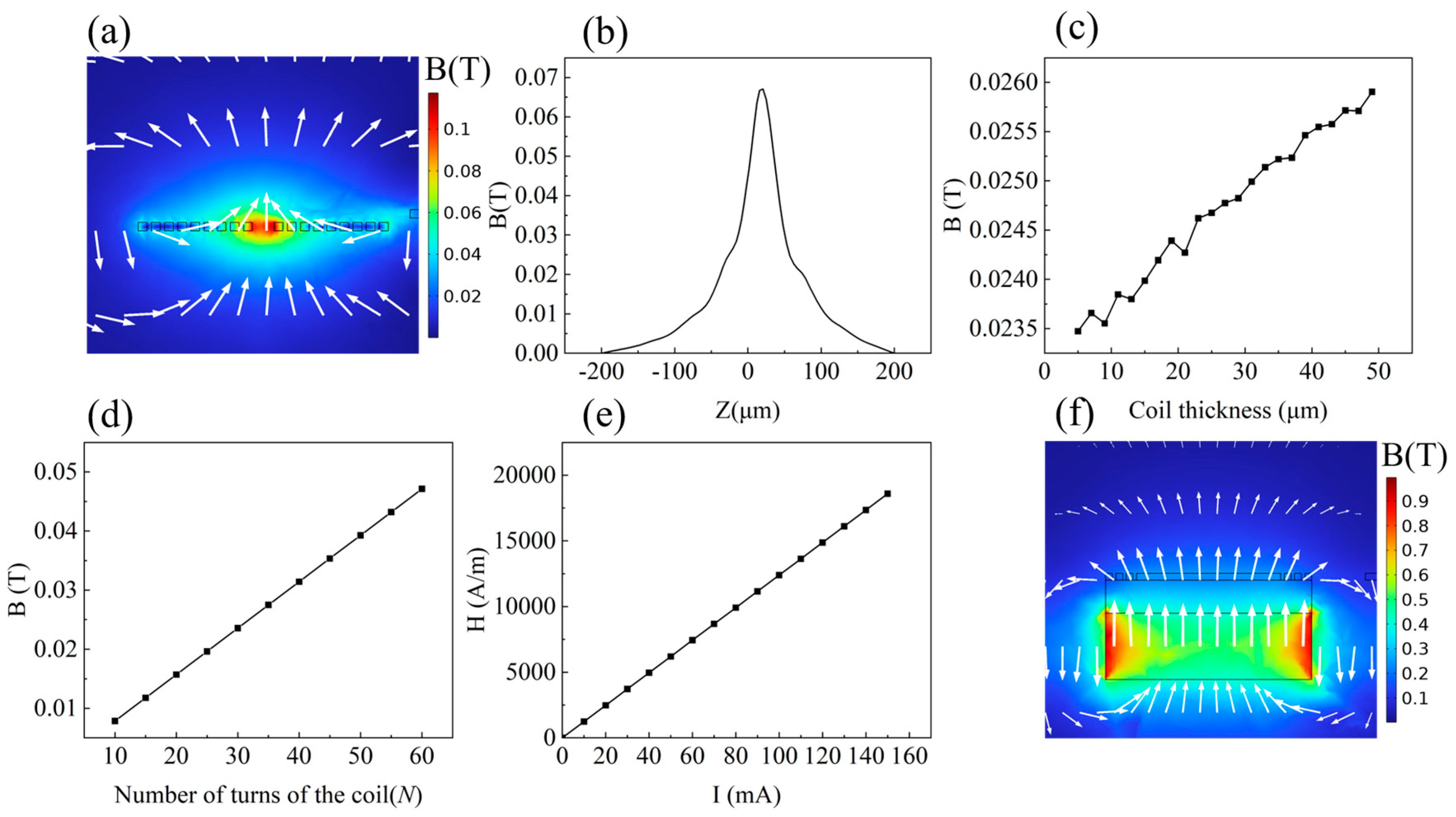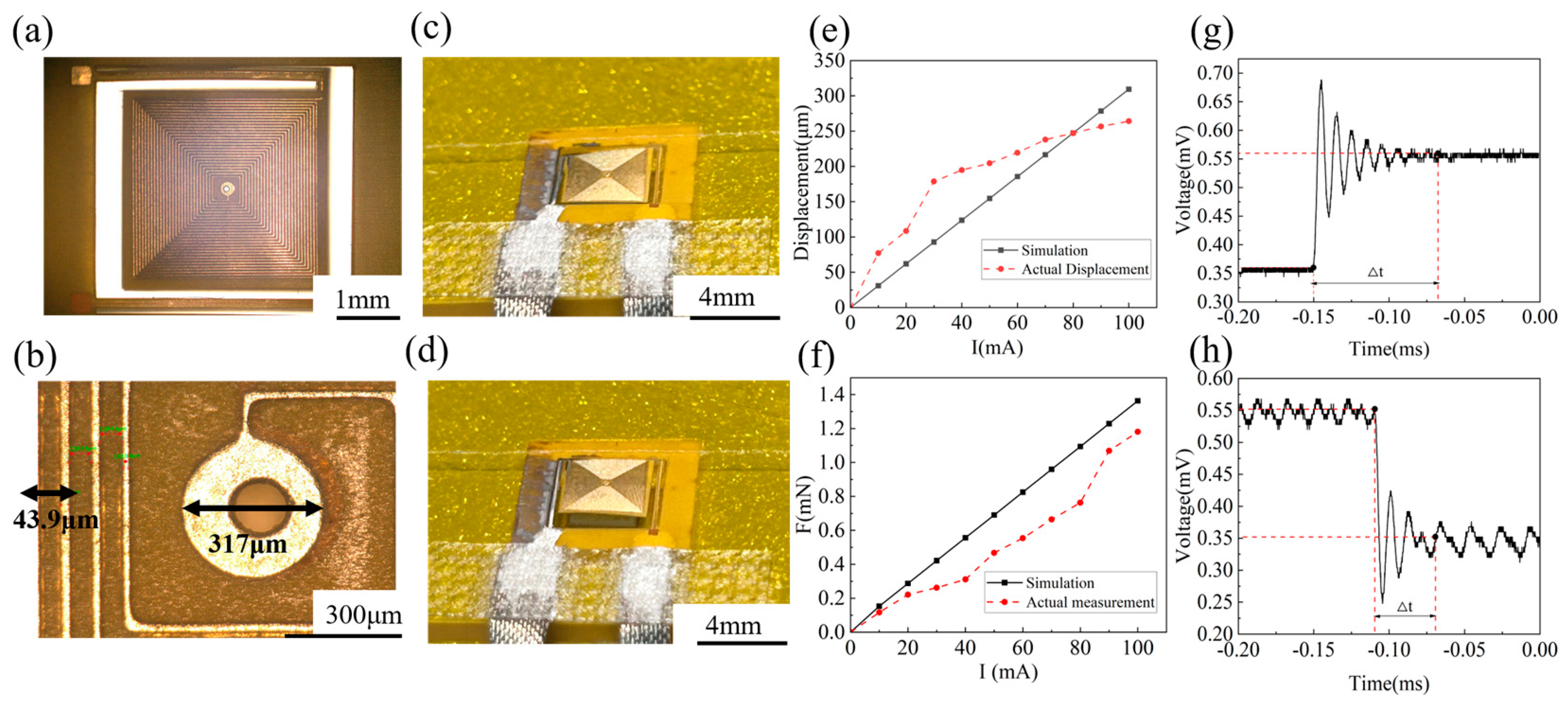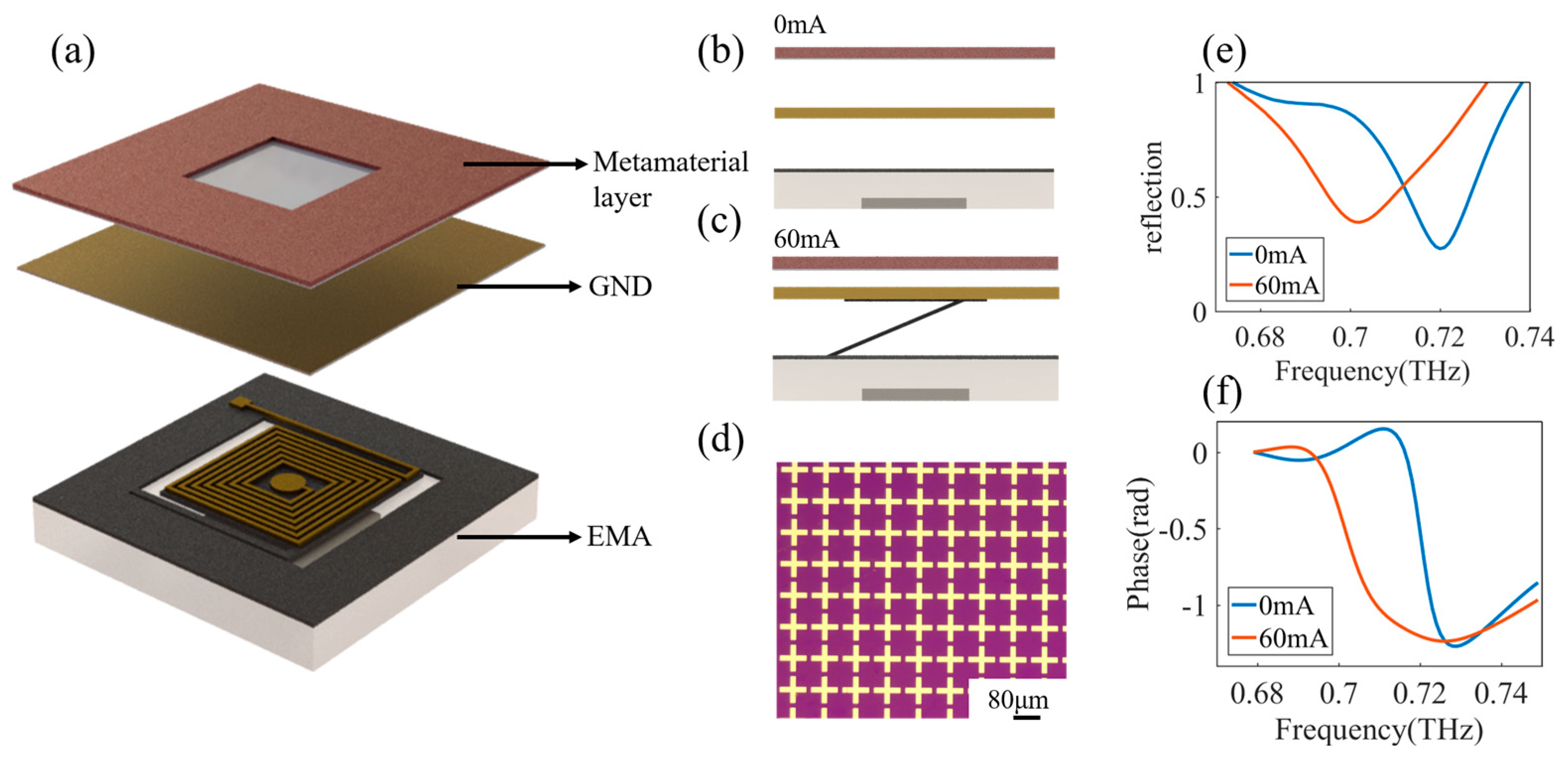Design and Implementation of a Flexible Electromagnetic Actuator for Tunable Terahertz Metamaterials
Abstract
1. Introduction
2. Theory and Design
3. Fabrication
4. Results and Discussion
5. Conclusions
Supplementary Materials
Author Contributions
Funding
Data Availability Statement
Acknowledgments
Conflicts of Interest
References
- Algamili, A.S.; Khir, M.H.M.; Dennis, J.O.; Ahmed, A.Y.; Alabsi, S.S.; Ba Hashwan, S.S.; Junaid, M.M. A Review of Actuation and Sensing Mechanisms in MEMS-Based Sensor Devices. Nanoscale Res. Lett. 2021, 16, 1–21. [Google Scholar] [CrossRef]
- Acome, E.; Mitchell, S.K.; Morrissey, T.G.; Emmett, M.B.; Benjamin, C.; King, M.; Radakovitz, M.; Keplinger, C. Hydraulically Amplified Self-Healing Electrostatic Actuators with Muscle-like Performance. Science 2018, 359, 61–65. [Google Scholar] [CrossRef]
- Mohith, S.; Upadhya, A.R.; Navin, K.P.; Kulkarni, S.M.; Rao, M. Recent Trends in Piezoelectric Actuators for Precision Motion and Their Applications: A Review. Smart Mater. Struct. 2021, 30, abc6b9. [Google Scholar] [CrossRef]
- Guo, Y.; Qiu, H.; Ruan, K.; Zhang, Y.; Gu, J. Hierarchically Multifunctional Polyimide Composite Films with Strongly Enhanced Thermal Conductivity. Nano-Micro Lett. 2022, 14, 1–13. [Google Scholar] [CrossRef] [PubMed]
- Doerger, S.R.; Harnett, C.K. Force-Amplified Soft Electromagnetic Actuators. Actuators 2018, 7, 76. [Google Scholar] [CrossRef]
- Younis, M.I. Sensing and ActuationActuationin MEMS. In MEMS Linear and Nonlinear Statics and Dynamics; Younis, M.I., Ed.; Springer: Boston, MA, USA, 2011; pp. 57–96. ISBN 978-1-4419-6020-7. [Google Scholar]
- Zhang, W.-M.; Yan, H.; Peng, Z.-K.; Meng, G. Electrostatic Pull-in Instability in MEMS/NEMS: A Review. Sens. Actuators A-Phys. 2014, 214, 187–218. [Google Scholar] [CrossRef]
- Sun, Y.-C.; Leaker, B.; Naguib, H.E. Development of Electrothermal Actuator (ETA) with Low Activation Voltage. In Behavior and Mechanics of Multifunctional Materials and Composites 2017; Goulbourne, N., Ed.; SPIE: Bellingham, WA, USA, 2017; Volume 10165. [Google Scholar]
- Van, L.L.; Bui, T.T.; Nhu, C.N.; Ngoc, A.N.; Dinh, T.X.; Dang, L.B.; Tran, C.-D.; Duc, T.C.; Dau, V.T. Simulation and Experimental Study of a Synthetic Jet Valveless Pump. IEEE-ASME Trans. Mechatron. 2020, 25, 1162–1170. [Google Scholar] [CrossRef]
- Gao, X.; Yang, J.; Wu, J.; Xin, X.; Li, Z.; Yuan, X.; Shen, X.; Dong, S. Piezoelectric Actuators and Motors: Materials, Designs, and Applications. Adv. Mater. Technol. 2020, 5, 1900716. [Google Scholar] [CrossRef]
- Sabarianand, D.V.; Karthikeyan, P.; Muthuramalingam, T. A Review on Control Strategies for Compensation of Hysteresis and Creep on Piezoelectric Actuators Based Micro Systems. Mech. Syst. Signal Process. 2020, 140, 106634. [Google Scholar] [CrossRef]
- Hofmann, U.; Oldsen, M.; Quenzer, H.-J.; Janes, J.; Heller, M.; Weiss, M.; Fakas, G.; Ratzmann, L.; Marchetti, E.; D’Ascoli, F.; et al. Wafer-Level Vacuum Packaged Micro-Scanning Mirrors for Compact Laser Projection Displays. In Moems And Miniaturized Systems VII; Dickensheets, D., Schenk, H., Eds.; SPIE: Bellingham, WA, USA, 2008; Volume 6887. [Google Scholar]
- Wagner, B.; Benecke, W. Magnetically Driven Microactuator: Design Considerations. In Micro System Technologies 90; Reichl, H., Ed.; Springer: Berlin/Heidelberg, Germany, 1990; pp. 838–843. ISBN 978-3-642-45678-7. [Google Scholar]
- Hansen, R.d.O.; Matefi-Tempfli, M.; Safonovs, R.; Adam, J.; Chemnitz, S.; Reimer, T.; Wagner, B.; Benecke, W.; Matefi-Tempfli, S. Magnetic Films for Electromagnetic Actuation in MEMS Switches. Microsyst. Technol.-Micro-Nanosyst.-Inf. Storage Process. Syst. 2018, 24, 1987–1994. [Google Scholar] [CrossRef]
- Sun, J.; Tao, Z.; Li, H.; Zhu, K.; Wang, D.; Wu, H.; Xu, T. A MEMS Voice Coil Motor with a 3D Solenoid Coil. In Proceedings of the 2021 IEEE 16th International Conference on Nano/Micro Engineered and Molecular Systems (NEMS), Xiamen, China, 25–29 April 2021; pp. 1745–1748. [Google Scholar]
- Jiang, B.; Peng, M.; Liu, Y.; Zhou, T.; Su, Y. The Fabrication of 2D Micromirror with Large Electromagnetic Driving Forces. Sens. Actuators A-Phys. 2019, 286, 163–168. [Google Scholar] [CrossRef]
- Mao, G.; Drack, M.; Karami-Mosammam, M.; Wirthl, D.; Stockinger, T.; Schwoediauer, R.; Kaltenbrunner, M. Soft Electromagnetic Actuators. Sci. Adv. 2020, 6, abc0251. [Google Scholar] [CrossRef]
- Liu, X.-J.; Zheng, M.-S.; Chen, G.; Dang, Z.-M.; Zha, J.-W. High-Temperature Polyimide Dielectric Materials for Energy Storage: Theory, Design, Preparation and Properties. Energy Environ. Sci. 2022, 15, 56–81. [Google Scholar] [CrossRef]
- Yi, C.; Li, W.; Shi, S.; He, K.; Ma, P.; Chen, M.; Yang, C. High-Temperature-Resistant and Colorless Polyimide: Preparations, Properties, and Applications. Sol. Energy 2020, 195, 340–354. [Google Scholar] [CrossRef]
- Lee, C.-Y.; Chen, Z.-H.; Chang, H.-T.; Wen, C.-Y.; Cheng, C.-H. Design and Fabrication of Novel Micro Electromagnetic Actuator. Microsyst. Technol. 2009, 15, 1171–1177. [Google Scholar] [CrossRef]
- Wang, Z.; Wu, Y.; Zhu, B.; Chen, Q.; Zhang, Y.; Xu, Z.; Sun, D.; Lin, L.; Wu, D. Self-Patterning of Highly Stretchable and Electrically Conductive Liquid Metal Conductors by Direct-Write Super-Hydrophilic Laser- Induced Graphene and Electroless Copper Plating. ACS Appl. Mater. Interfaces 2023, 15, 4713–4723. [Google Scholar] [CrossRef] [PubMed]
- Sun, Z.; Liang, C.; Chen, C.; Wang, X.; Zhou, E.; Bian, X.; Yang, Y.; You, R.; Zhao, X.; Zhao, J.; et al. High-Efficiency Dynamic Terahertz Deflector Utilizing a Mechanically Tunable Metasurface. Research 2023, 6, 274. [Google Scholar] [CrossRef]
- Xiong, X.; Xie, H. MEMS dual-mode electrostatically actuated micromirror. In Proceedings of the 2014 Zone 1 Conference of the American Society for Engineering Education, Bridgeport, CT, USA, 3–5 April 2014; pp. 1–7. [Google Scholar] [CrossRef]
- Liu, M.; Susli, M.; Silva, D.; Putrino, G.; Kala, H.; Fan, S.; Cole, M.; Faraone, L.; Wallace, V.P.; Padilla, W.J.; et al. Ultrathin Tunable Terahertz Absorber Based on MEMS-Driven Metamaterial. Microsyst. Nanoeng. 2017, 3, 1–6. [Google Scholar] [CrossRef]
- Xiao, S.; Wang, T.; Liu, T.; Zhou, C.; Jiang, X.; Zhang, J. Active Metamaterials and Metadevices: A Review. J. Phys. D-Appl. Phys. 2020, 53, 503002. [Google Scholar] [CrossRef]
- Xing, Z.; Ji, Y.; McCoul, D.; Jin, T.; Zhao, J. Electromagnetic Force Distribution of Planar Coils: Analytical Model and Optimization. Electr. Power Compon. Syst. 2022, 49, 967–977. [Google Scholar] [CrossRef]
- Shi, X.; Ren, C.; Li, Y.; Ding, G. Design, Modeling, and Optimization of a Bistable Electromagnetic Actuator With Large Deflection. IEEE Magn. Lett. 2021, 12, 3099373. [Google Scholar] [CrossRef]
- Zhang, Y.-F.; Li, D.-S. Fabrication and Simulation of an Electromagnetic Microrelay. J. Semicond. 2002, 23, 1298–1302. [Google Scholar] [CrossRef]
- Liu, X.; Whalen, A.J.; Kim, K.; Cai, C.; Lauritzen, M.; Bertram, N.; Chang, B.; Yu, T.; Han, A.; Woo, S.; et al. MEMS Micro-Coils for Magnetic Neurostimulation. Biosens. Bioelectron. 2023, 227, 115143. [Google Scholar] [CrossRef]
- Wang, G.; Valla, M.; Solsona, J. Position Sensorless Permanent Magnet Synchronous Machine Drives—A Review. IEEE Trans. Ind. Electron. 2020, 67, 5830–5842. [Google Scholar] [CrossRef]
- Cui, T.J.; Li, L.; Liu, S.; Ma, Q.; Zhang, L.; Wan, X.; Jiang, W.X.; Cheng, Q. Information Metamaterial Systems. iScience 2020, 23, 101403. [Google Scholar] [CrossRef] [PubMed]
- Chen, C.; Can, S.; Schalch, J.; Zhao, X.; Duan, G.; Averitt, R.D.; Zhang, X. Ultrathin Terahertz Triple-Band Metamaterial Absorbers: Consideration of Interlayer Coupling. Phys. Rev. Appl. 2020, 14, 054021. [Google Scholar] [CrossRef]
- Carrara, M.; Cacan, M.R.; Toussaint, J.; Leamy, M.J.; Ruzzene, M.; Erturk, A. Metamaterial-Inspired Structures and Concepts for Elastoacoustic Wave Energy Harvesting. Smart Mater. Struct. 2013, 22, 065004. [Google Scholar] [CrossRef]
- Vasilantonakis, N.; Wurtz, G.A.; Podolskiy, V.A.; Zayats, A.V. Refractive Index Sensing with Hyperbolic Metamaterials: Strategies for Biosensing and Nonlinearity Enhancement. Opt Express 2015, 23, 14329. [Google Scholar] [CrossRef]
- Watts, C.M.; Shrekenhamer, D.; Montoya, J.; Lipworth, G.; Hunt, J.; Sleasman, T.; Krishna, S.; Smith, D.R.; Padilla, W.J. Terahertz Compressive Imaging with Metamaterial Spatial Light Modulators. Nat. Photonics 2014, 8, 605–609. [Google Scholar] [CrossRef]
- Lv, X.; Wei, W.; Mao, X.; Chen, Y.; Yang, J.; Yang, F. A Novel MEMS Electromagnetic Actuator with Large Displacement. Sens. Actuators A-Phys. 2015, 221, 22–28. [Google Scholar] [CrossRef]
- Miao, X.; Dai, X.; Huang, Y.; Ding, G.; Zhao, X. Large Out-of-Plane Displacement Bistable Electromagnetic Microswitch on a Single Wafer. Sensers 2016, 16, 634. [Google Scholar] [CrossRef] [PubMed]
- Dehghan, M.; Tahmasebipour, M.; Ebrahimi, S.S.S. Design, Fabrication, and Characterization of an SLA 3D Printed Nanocomposite Electromagnetic Microactuator. Microelectron. Eng. 2021, 254, 111695. [Google Scholar] [CrossRef]
- Lee, S.W.; Lee, S.S. Focal Tunable Liquid Lens Integrated with an Electromagnetic Actuator. Appl. Phys. Lett. 2007, 90, 121129. [Google Scholar] [CrossRef]
- Song, K.; Kim, S.; Cha, Y. Soft Electromagnetic Actuator for Assembly Robots. Smart Mater. Struct. 2020, 29, 067001. [Google Scholar] [CrossRef]
- Liu, B.; Li, D.; Yang, X.; Li, X. Design and Fabrication of a Micro Electromagnetic Actuator. In Proceedings of the 2006 1st IEEE International Conference on Nano/Micro Engineered and Molecular Systems, Zhuhai, China, 18–21 January 2006; pp. 353–356. [Google Scholar]






| Parameter | Value |
|---|---|
| Length of the side of the glass substrate (L) | 8 mm |
| Thickness of glass substrate (H) | 2 mm |
| Length of the side of the permanent magnet (l) | 3 mm |
| Thickness of permanent magnet (h) | 300 μm |
| Length of supporting cantilever beam (LBEAM) | 4300 μm |
| Width of the supporting cantilever beam (WBEAM) | 200 μm |
| Thickness of the supporting cantilever beam (P) | 60 μm |
| Length of the side of the movable plate (LMP) | 4 mm |
| Coil width (Wwire) | 10 μm |
| Coil thickness (twire) | 30 μm |
| Number of turns of the coil (N) | 26 |
Disclaimer/Publisher’s Note: The statements, opinions and data contained in all publications are solely those of the individual author(s) and contributor(s) and not of MDPI and/or the editor(s). MDPI and/or the editor(s) disclaim responsibility for any injury to people or property resulting from any ideas, methods, instructions or products referred to in the content. |
© 2024 by the authors. Licensee MDPI, Basel, Switzerland. This article is an open access article distributed under the terms and conditions of the Creative Commons Attribution (CC BY) license (https://creativecommons.org/licenses/by/4.0/).
Share and Cite
Zhou, S.; Liang, C.; Mei, Z.; Xie, R.; Sun, Z.; Li, J.; Zhang, W.; Ruan, Y.; Zhao, X. Design and Implementation of a Flexible Electromagnetic Actuator for Tunable Terahertz Metamaterials. Micromachines 2024, 15, 219. https://doi.org/10.3390/mi15020219
Zhou S, Liang C, Mei Z, Xie R, Sun Z, Li J, Zhang W, Ruan Y, Zhao X. Design and Implementation of a Flexible Electromagnetic Actuator for Tunable Terahertz Metamaterials. Micromachines. 2024; 15(2):219. https://doi.org/10.3390/mi15020219
Chicago/Turabian StyleZhou, Shengru, Chao Liang, Ziqi Mei, Rongbo Xie, Zhenci Sun, Ji Li, Wenqiang Zhang, Yong Ruan, and Xiaoguang Zhao. 2024. "Design and Implementation of a Flexible Electromagnetic Actuator for Tunable Terahertz Metamaterials" Micromachines 15, no. 2: 219. https://doi.org/10.3390/mi15020219
APA StyleZhou, S., Liang, C., Mei, Z., Xie, R., Sun, Z., Li, J., Zhang, W., Ruan, Y., & Zhao, X. (2024). Design and Implementation of a Flexible Electromagnetic Actuator for Tunable Terahertz Metamaterials. Micromachines, 15(2), 219. https://doi.org/10.3390/mi15020219








